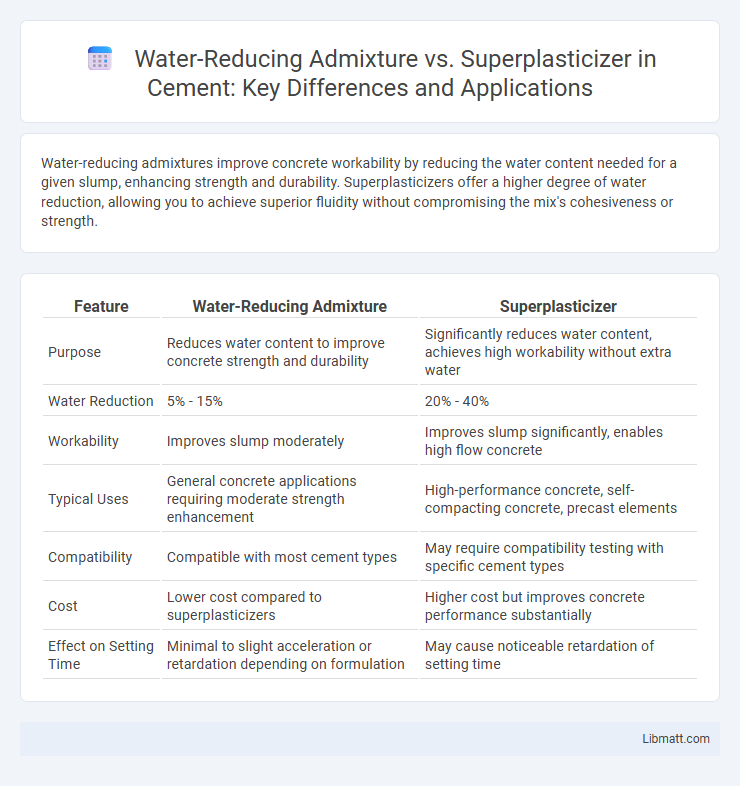Water-reducing admixtures improve concrete workability by reducing the water content needed for a given slump, enhancing strength and durability. Superplasticizers offer a higher degree of water reduction, allowing you to achieve superior fluidity without compromising the mix's cohesiveness or strength.
Table of Comparison
| Feature | Water-Reducing Admixture | Superplasticizer |
|---|---|---|
| Purpose | Reduces water content to improve concrete strength and durability | Significantly reduces water content, achieves high workability without extra water |
| Water Reduction | 5% - 15% | 20% - 40% |
| Workability | Improves slump moderately | Improves slump significantly, enables high flow concrete |
| Typical Uses | General concrete applications requiring moderate strength enhancement | High-performance concrete, self-compacting concrete, precast elements |
| Compatibility | Compatible with most cement types | May require compatibility testing with specific cement types |
| Cost | Lower cost compared to superplasticizers | Higher cost but improves concrete performance substantially |
| Effect on Setting Time | Minimal to slight acceleration or retardation depending on formulation | May cause noticeable retardation of setting time |
Introduction to Concrete Admixtures
Water-reducing admixtures enhance concrete workability and strength by decreasing water content without compromising mix consistency, optimizing the hydration process. Superplasticizers provide a higher range of water reduction, significantly improving flowability for complex structures while maintaining durability. You can choose between these admixtures based on the required slump, strength, and project specifications to achieve superior concrete performance.
Defining Water-Reducing Admixtures
Water-reducing admixtures are chemical additives designed to decrease the water content in concrete mixtures while maintaining workability and strength. These admixtures improve the hydration process, resulting in enhanced durability and reduced permeability of the concrete. Superplasticizers represent a high-range category of water-reducing admixtures, providing greater fluidity and slump retention for high-performance concrete applications.
What Are Superplasticizers?
Superplasticizers are advanced water-reducing admixtures designed to enhance concrete fluidity without increasing water content, improving workability and strength. They allow you to achieve high-performance concrete by dispersing cement particles more efficiently, resulting in superior durability and reduced permeability. Unlike standard water reducers, superplasticizers significantly lower water-to-cement ratios, making them essential for modern construction demanding precision and quality.
Key Differences: Water-Reducers vs Superplasticizers
Water-reducing admixtures decrease the water content in concrete mixtures to improve strength and durability without significantly altering workability. Superplasticizers, on the other hand, provide a higher degree of water reduction while drastically enhancing the fluidity and flow of the concrete, allowing for easier placement and compaction. Your choice depends on the level of workability and strength required for the specific construction application.
Mechanisms of Action: How Do They Work?
Water-reducing admixtures work by dispersing cement particles through electrostatic repulsion, allowing you to reduce the water content while maintaining workability. Superplasticizers, or high-range water reducers, enhance this effect by using high-molecular-weight polymers that provide both electrostatic and steric stabilization, significantly improving fluidity without increasing water. Understanding these mechanisms helps optimize concrete mix designs for strength and durability.
Effects on Concrete Workability
Water-reducing admixtures enhance concrete workability by lowering the water-cement ratio, leading to improved strength and durability with minimal impact on slump retention. Superplasticizers provide a higher level of workability by significantly increasing fluidity without additional water, allowing for easier placement and compaction in complex forms or congested reinforcement. The choice between these admixtures depends on the required slump, concrete mix design, and specific application demands for achieving optimal workability and performance.
Impact on Strength and Durability
Water-reducing admixtures enhance concrete strength by reducing water content while maintaining workability, resulting in denser and more durable structures. Superplasticizers provide higher water reduction levels, significantly improving strength and durability by producing high-performance concrete with greater fluidity and reduced porosity. Both admixtures contribute to improved long-term durability by minimizing permeability and enhancing resistance to freeze-thaw cycles and chemical attacks.
Typical Applications in Construction
Water-reducing admixtures are commonly used in general concrete applications to improve workability and reduce water content, enhancing strength and durability for structural elements like slabs, beams, and columns. Superplasticizers are preferred for high-performance concrete that requires significant fluidity without increasing water, ideal for precast components, high-rise buildings, and intricate formwork. You can optimize concrete mix designs by selecting water-reducing admixtures for standard projects and superplasticizers for demanding construction scenarios requiring superior flow and strength.
Selection Criteria: Choosing the Right Admixture
Selecting the right admixture hinges on your project's specific concrete performance requirements and water reduction goals. Water-reducing admixtures improve workability with moderate water reduction, while superplasticizers provide high-range water reduction for superior flow and strength. Consider factors such as setting time, compatibility with cement types, and environmental conditions to optimize your concrete mix design.
Recent Innovations and Future Trends
Recent innovations in water-reducing admixtures and superplasticizers emphasize enhanced molecular designs that improve cement particle dispersion, resulting in higher strength and durability of concrete. Nanotechnology integration and bio-based additives are emerging trends aimed at sustainable construction by reducing environmental impact and improving workability without compromising performance. Your choice between these admixtures depends on specific project requirements and desired concrete properties, as future advancements will tailor formulations for optimized efficiency and eco-friendliness.
Water-reducing admixture vs Superplasticizer Infographic

 libmatt.com
libmatt.com